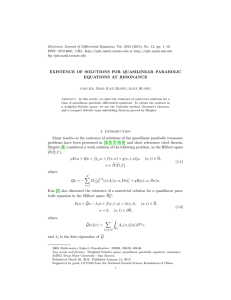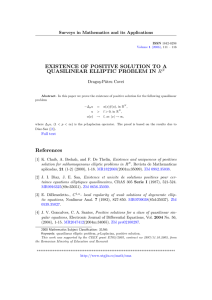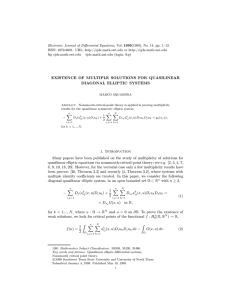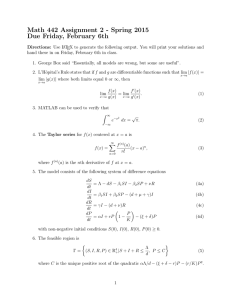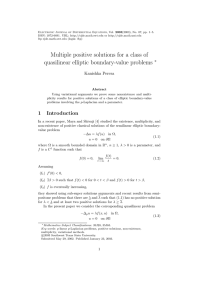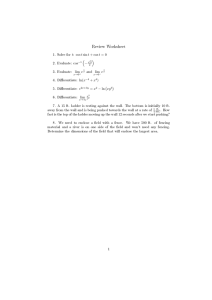Document 10815362
advertisement
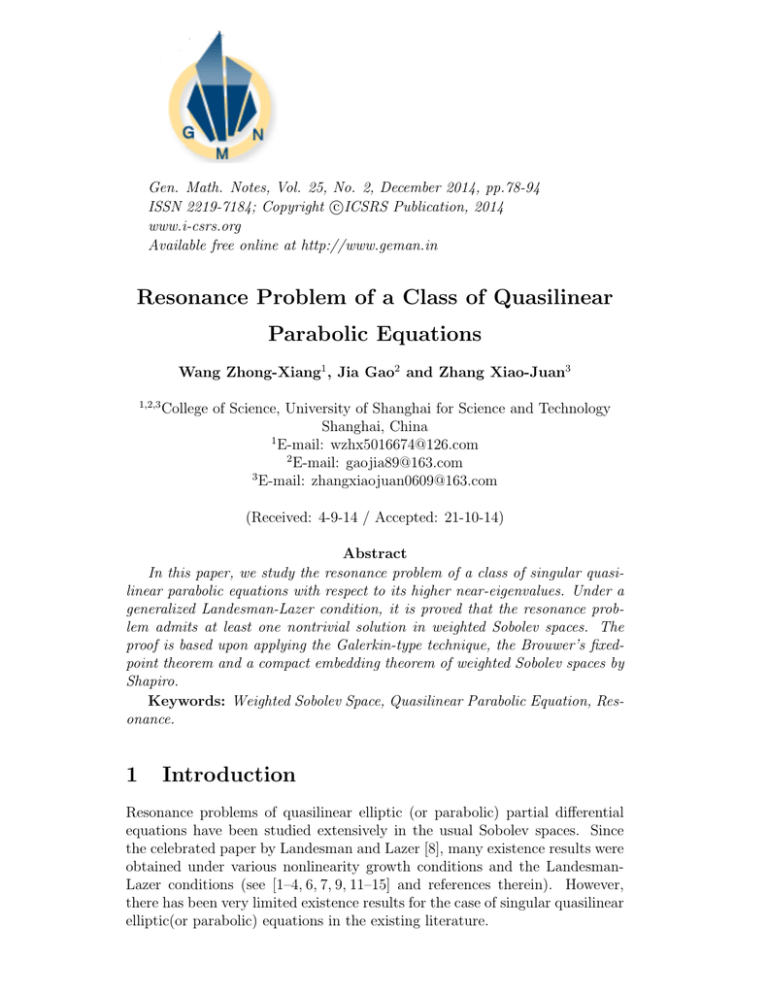
Gen. Math. Notes, Vol. 25, No. 2, December 2014, pp.78-94
c
ISSN 2219-7184; Copyright ICSRS
Publication, 2014
www.i-csrs.org
Available free online at http://www.geman.in
Resonance Problem of a Class of Quasilinear
Parabolic Equations
Wang Zhong-Xiang1 , Jia Gao2 and Zhang Xiao-Juan3
1,2,3
College of Science, University of Shanghai for Science and Technology
Shanghai, China
1
E-mail: wzhx5016674@126.com
2
E-mail: gaojia89@163.com
3
E-mail: zhangxiaojuan0609@163.com
(Received: 4-9-14 / Accepted: 21-10-14)
Abstract
In this paper, we study the resonance problem of a class of singular quasilinear parabolic equations with respect to its higher near-eigenvalues. Under a
generalized Landesman-Lazer condition, it is proved that the resonance problem admits at least one nontrivial solution in weighted Sobolev spaces. The
proof is based upon applying the Galerkin-type technique, the Brouwer’s fixedpoint theorem and a compact embedding theorem of weighted Sobolev spaces by
Shapiro.
Keywords: Weighted Sobolev Space, Quasilinear Parabolic Equation, Resonance.
1
Introduction
Resonance problems of quasilinear elliptic (or parabolic) partial differential
equations have been studied extensively in the usual Sobolev spaces. Since
the celebrated paper by Landesman and Lazer [8], many existence results were
obtained under various nonlinearity growth conditions and the LandesmanLazer conditions (see [1–4, 6, 7, 9, 11–15] and references therein). However,
there has been very limited existence results for the case of singular quasilinear
elliptic(or parabolic) equations in the existing literature.
Resonance Problem of a Class of Quasilinear...
79
In 2001, Shapiro published a paper [12] on the resonance problems of singular quasilinear equations. An important element of that paper is the existence
of a complete orthonormal basis in the weighted Sobolev space associated with
singular coefficients of the differential operator. In that paper, a new concept
of near-eigenvalues for singular quasilinear elliptic operators was introduced,
a new compact embedding theorem in the weighted Sobolev spaces was established, and some new existence results for the resonance problems were
obtained.
In 2002, Chung-Cheng Kuo [7] applied Galerkin-type techniques and Brouwer’s
fixed point theorem to obtain existence theorems of time-periodic solutions
for quasilinear parabolic partial differential equations with respect to its first
eigenvalue in which the Landesman-Lazer condition may be excluded.
In 2005, Rumbos and Shapiro [11] introduced a generalized LandesmanLazer condition and studied the resonance problem of the semilinear elliptic
equations with respect to its first eigenvalue by using the linking argument
and a deformation theorem in weighted Sobolev spaces.
Inspired by papers [9, 10, 12, 14], we have studied the resonance problem of
quasilinear or singular quasilinear elliptic(or parabolic) equations in weighted
Sobolev spaces with respect to their first eigenvalues by using the Galerkintype technique and the Brouwer’s fixed-point theorem [2–4].
Motivated by [10–12], in this paper, we show the existence of solutions for
a class of singular quasilinear parabolic equations with respect to its higher
e Ω,
e Γ):
near-eigenvalue in the Hilbert space H(
(
e
ρDt u + Mu = (λj0 u + b(x, t, u)u− + f (x, t, u))ρ − G, (x, t) ∈ Ω,
(P )
e Ω,
e Γ),
u ∈ H(
where
Mu = −
N
X
1
1
1
1
Di [pi2 (x)pj2 (x)si2 (u)sj2 (u)aij (x)Dj u] + a0 (x)s0 (u)qu,
(1.1)
i,j=1
and λj0 is an eigenvalue of L.
As in paper [3], we assume the existence of a linear uniformly elliptic operator which is close to the original singular quasilinear operator in a certain
sense, and hence the existence of a complete orthonormal basis in the weighted
Sobolev space associated with singular coefficients of the differential operator.
However, unlike the case of the first near-eigenvalue which is simple and whose
eigenfunction is of one-sign, the case of higher near-eigenvalue is challenging to
study due to the fact that the multiplicity of higher near-eigenvalue is greater
than 1 and their corresponding eigenfunctions are sign-changing. By using a
space decomposition technique, we are able to prove that the resonance problem has at least one solution under a generalized Landesman-Lazer condition.
80
Wang Zhong-Xiang et al.
The proof method is similar to [12] and [4], which is based also upon applying the Galerkin-type technique, the Brouwer’s fixed-point theorem and the
compact embedding theorem of weighted Sobolev spaces by Shapiro [12].
This paper is organized as follows. In Section 2, we describe the resonance
problem of a class of singular quasilinear parabolic equations to be studied,
and state the main result. In Section 3, we prove the main theorem.
2
Statement of the Problem and Main Result
Let Ω ⊂ RN (N ≥ 1), be an open set(possibly unbounded) and let ρ(x), pi (x) ∈
C 0 (Ω) be positive functions with the property that
Z
Z
Z
pi (x)dx < ∞, i = 1, 2, · · · , N. (2.1)
q(x)dx < ∞,
ρ(x)dx < ∞,
Ω
Ω
Ω
Let q(x) ∈ C 0 (Ω) be a nonnegative function and Γ ⊂ ∂Ω be a fixed closed set.
Note that Γ may be an empty set and q(x) may be zero. On the other hand,
q(x) will satisfy: there exists K > 0, such that
0 ≤ q(x) ≤ Kρ(x), for all x ∈ Ω.
(2.2)
Here A is a set of real-valued functions defined as
A = {u : u ∈ C 0 (Ω̄ × R), u(x, t + 2π) = u(x, t), for all (x, t) ∈ Ω̄ × R}.
e = Ω×T, T = (−π, π), p = (p1 , · · · , pN ) and Di = ∂u (i = 1, 2, · · · , N ),
Setting Ω
∂xi
we consider the following pre-Hilbert spaces (see [12]):
Z
2
0
0
e = u ∈ C (Ω)
e :
eρ (Ω)
C
|u(x, t)| ρ(x)dxdt < ∞ ,
e
Ω
with inner product hu, vi∼
ρ =
R
u(x, t)v(x, t)ρ(x)dxdt, and the space
1 e
1
e
Cp,ρ (Ω, Γ) = {u ∈ A ∩ C (Ω × R)u(x, t) = 0, for all (x, t) ∈ Γ × R;
e
Ω
Z X
N
[
|Di u|2 pi + (u2 + |Dt u|2 )ρ] < ∞}
e
Ω
i=1
with inner product
hu, viHe =
Z "X
N
e
Ω
i=1
#
pi Di uDi v + (uv + Dt uDt v)ρ dxdt.
81
Resonance Problem of a Class of Quasilinear...
e2 , L2 (Ω)
e denote the Hilbert space obtained from the completion of C
e0
Let L
ρ
ρ
ρ
1
e , H(
e Ω,
e Γ) denote the completion
2 , and H
with the norm ||u||ρ = (hu, ui∼
)
ρ
1
1
e
e2p (i =
of the space Cp,ρ with the norm ||u|| e = hu, ui 2 . Similarly, we have L
H
i
e
H
e2 .
1, 2, · · ·, N ) and L
q
It is assumed throughout the paper that si (u)(i = 0, 1, · · · , N ) meets:
e → R is weakly sequentially continuous;
(S1) si (u): H
(S2) there exist η0 , η1 > 0 such that η0 ≤ si (u) ≤ η1 , and si (u) is measure
able, for u ∈ H.
The functions aij (i, j = 1, 2, · · T
· , N ) and a0 (x) satisfy(also bij (x) and b0 (x)):
0
(A1) a0 (x), aij (x) ∈ C (Ω) L∞ (Ω), aij (x) = aji (x), ∀x ∈ Ω;
(A2) a0 (x) ≥ β0 > 0, ∀x ∈ Ω;
N
P
(A3) there exists c0 > 0, for x ∈ Ω and ξ ∈ RN , such that
aij (x)ξi ξj ≥
i,j=1
c0 | ξ |2 .
Furthermore, we assume both Caratheodory functions b(x, t, s) and f (x, t, s)
satisfy the following conditions.
(B1) There exist constants δ > 0 and k > 1 such that
δ|s|,
|s| ≤ γ1 ,
(2.3)
|b(x, t, s)| ≤
δγ1
,
|s| > γ1 ,
(|s|+1−γ1 )m
−λ
λ
and 0 < γ1 < 1, where γ1 = j0 +jk1 j0 and m ≥ 1.
Conditions on f (x, t, s):
e2 such that
(f1) There exists a nonnegative function f0 (x, t) ∈ L
ρ
|f (x, t, s)| ≤ f0 (x, t), for a.e. x ∈ Ω and ∀s ∈ R;
(f2) lim sups→+∞ f (x, t, s) = f + (x, t) ∈ L∞ (Ω), lim inf s→−∞ f (x, t, s) =
f − (x, t) ∈ L∞ (Ω).
It is, in general, difficult to study the eigenvalues and eigenfunctions of
M. Shapiro [12] introduced the concepts of near-related operators and neareigenvalue of M.
We first introduce some operators related to this paper.
Definition 2.1. For the quasilinear differential operator M, the two form
is
M(u, v) =
N Z h
X
i,j=1
i Z
e Ω,
e Γ).
pi pj si (u)sj (u)aij Dj uDi v + qs0 (u)a0 uv, u, v ∈ H(
1
2
1
2
1
2
1
2
e
Ω
e
Ω
(2.4)
Defining
Lx u = −
N
X
i,j=1
h 1 1
i
Di pi2 pj2 bij Dj u + b0 qu,
(2.5)
82
Wang Zhong-Xiang et al.
for u ∈ Hp,q,ρ = Hp,q,ρ (Ω, Γ) (as described in [12]), and
Lu = −
N
X
h 1 1
i
2 2
e Ω,
e Γ),
Di pi pj bij Dj u + a0 qu, u ∈ H(
(2.6)
i,j=1
then the bilinear form of Lx is
Lx (u, v) =
N Z
X
i,j=1
1
2
Z
1
2
b0 uvq, u, v ∈ Hp,q,ρ (Ω, Γ) , (2.7)
pi pj bij (x)Dj uDi v +
Ω
Ω
and the bilinear form of L is
L(u, v) =
N Z
X
i,j=1
1
2
1
2
Z
e Ω,
e Γ).
b0 uvq, u, v ∈ H(
pi pj bij (x)Dj uDi v +
e
Ω
(2.8)
e
Ω
We further assume that domain Ω and operator Lx satisfy the so-called
VL (Ω, Γ) conditions [12, 14]:
(VL -1) There exists a complete orthonormal sequence of functions {ϕn }∞
n=1
1
(Ω, Γ) ∩ C 2 (Ω) for all n.
in L2ρ (Ω), such that ϕn ∈ Hp,q,ρ
(VL -2) The uniformly elliptic operator Lx has a sequence of real eigenvalues
∞
{λn }∞
n=1 corresponding to the orthonormal sequence {ϕn }n=1 , satisfying
0 < λ1 < λ2 ≤ λ3 ≤ · · · ≤ λn → ∞ as n → ∞,
and
1
Lx (ϕn , v) = λn hϕn , viρ , ∀v ∈ Hp,q,ρ
(Ω, Γ) and n ≥ 1.
Also ϕ1 > 0 in Ω. R
Here hu, viρ = Ωe uvρ. For the sake of simplicity, in the following, we will
denote hu, viρ as hu, vi.
Examples of operators and domains for which the VL (Ω, Γ) conditions hold
can be found in [12](pp. 20-26). The VL (Ω, Γ) conditions play a key role in
our study of the resonance problem of singular quasilinear elliptic equations.
Definition 2.2. Operator M is said to be near-related to operator L(denoted
e
as M ∼ L for convenience), if, for any v ∈ H,
M(u, v) − L(u, v)
= 0.
||u||H
||u||He
e →∞
lim
(2.9)
Resonance Problem of a Class of Quasilinear...
83
e λ is called a near-eigenvalue of M
Definition 2.3. Assume M ∼ L in H.
if
u)−L(u,Pλ u)
(1) λ is an eigenvalue of Lx ; (2) lim||u||He →∞ M(u,Pλ||u||
= 0,
e
H
where Pλ is the orthogonal projection from L2ρ (Ω) onto the eigenspace of Lx
corresponding to the eigenvalue λ.
We now state the main result of this paper:
e = Ω × T, p =
Theorem 2.4. Let Ω ⊂ RN (N ≥ 1), T = (−π, π), Ω
(p1 , · · · , pN ), ρ and pi (i = 1, · · · , N ) be positive functions in C 0 (Ω) satisfying
(2.1), q ∈ C 0 (Ω) be a nonnegative function satisfying (2.2), and Γ ⊂ ∂Ω be
a closed set. Let M and L be given by (1.1) and (2.6) satisfying (S1)-(S2),
(A1)-(A3) respectively and Lx satisfies the conditions of VL (Ω, Γ). If M ∼ L,
λj0 is a near-eigenvalue of M of multiplicity j1 , (B1) and (f1)-(f2) hold, and
e ∗ , then the problem (P) has at least one weak solution; i.e., there exits
G ∈ (H)
e such that
u∗ ∈ H
e
hDt u∗ , viρ +M(u∗ , v) = λj0 hu∗ , viρ +hf (x, t, u∗ )+g(x, t, u∗ ), viρ −G(v), ∀v ∈ H.
(2.10)
Here, we will introduce some lemmas and concepts which will be used later.
If (A1)-(A3) and the conditions of VL (Ω, Γ) hold, we have
∞,∞
e2 ,
esjk }j=1,k=1
is a CONS for L
{ϕ
ecjk }∞,∞
ρ
j=1,k=0 ∪ {ϕ
where
(
ϕ
ecjk (x, t)
=
ϕj (x)
√
,
2π
ϕj (x) cos(kt)
√
,
π
k = 0, j = 1, 2, · · · ,
k, j = 1, 2, · · · ,
(2.11)
(2.12)
and
ϕ
esjk (x, t) =
ϕj (x) sin(kt)
√
, k, j = 1, 2, · · · .
π
(2.13)
e Ω,
e Γ).
Obviously, both ϕ
ecjk and ϕ
esjk are in H(
2 e
Lemma 2.5. If {ϕ
ecjk }∞,∞
esjk }∞,∞
j=1,k=0 ∪ {ϕ
j=1,k=1 is a CONS for Lρ (Ω) defined by
(2.11), setting
τn (v) =
n
X
vbc (j, 0)ϕ
ecj0 +
j=1
n X
n
X
esjk ,
vbc (j, k)ϕ
ecjk + vbs (j, k)ϕ
(2.14)
j=1 k=1
we have
e
lim ||τn (v) − v||He = 0, for all v ∈ H.
n→∞
(2.15)
84
Wang Zhong-Xiang et al.
e then
Lemma 2.6. (i) If v ∈ H,
L1 (v, v) + ||Dt v||2ρ =
∞
X
|b
v c (j, 0)|2 (λj + 1)
j=1
∞ X
∞
X
c
+
|b
v (j, k)|2 + |b
v s (j, k)|2 λj + 1 + k 2 .
(2.16)
j=1 k=1
e and L1 (v, v) + ||Dt v||2 < ∞, then v ∈ H.
e Here L1 (v, v) =
(ii) If v ∈ L2ρ (Ω)
ρ
L(v, v)+ < v, v > .
e ρ, p, q, and L be as in the hypothesis of Theorem 2.1
Lemma 2.7. Let Ω,
e is compactly imbedded in L2ρ (Ω).
e
and assume that (Ω, Γ) is a VL (Ω, Γ) . Then H
The proofs of Lemmas 2.1-2.3 can be found in [12]. We define the set
)
(
n
n X
n
X
X
c
s
c
s
c
e :v=
ηjk
ϕ
ecjk + ηjk
ϕ
esjk , ηjk
, ηjk
∈R .
Sn = v ∈ H
ηj0
ϕ
ecj0 +
j=1
j=1 k=1
(2.17)
Remark 2.8. (1) If un ∈ Sn , then M(un , Dt un ) = 0; (2) hDt (αϕ
ecjk +
s
c
s
βϕ
ejk ), αϕ
ejk + β ϕ
ejk i = 0, j, k ≥ 1, α, β ∈ R.
3
Proof of Theorem 2.1
The proof of Theorem 2.1 can be divided into three steps. The first step is to
e where un ∈ Sn
construct a set of approximate solutions {un } of (2.10) in H,
and Sn is defined as in (2.17). Then we show in the second step that {un } is
e Finally, we show {un } converges to a weak solution u∗ ∈ H
e of
bounded in H.
(2.10).
Lemma 3.1. Assume that all the conditions in the hypothesis of Theorem
e defined by (2.17). Taking n0 = j0 + j1
2.1 hold. Let Sn be the subspace of H
and γ0 = 12 (λj0 +j1 − λj0 ), then for n ≥ n0 , there is a function un ∈ Sn with the
property that
hDt un , vi + M(un , v) =(λj0 + γ0 n−1 )hun , vi + hb(x, t, un )(un )− , vi
+(1 − n−1 )hf (x, t, un ), vi − G(v), ∀v ∈ Sn .
(3.1)
2
+n
Proof. Let {ψi }2n
be an enumeration of {ϕ
ecjk }n,n
esjk }n,n
i=1
j=1,k=0 ∪ {ϕ
j=1,k=1 , and set
n∗ = (j0 + j1 − 1)(2n + 1).
∗
(3.2)
j0 +j1 −1,n
j0 +j1 −1,n
So {ψi }ni=1 is an enumeration of {ϕ
ecjk }j=1,k=0
∪ {ϕ
esjk }j=1,k=1
, where n ≥ n0 .
85
Resonance Problem of a Class of Quasilinear...
With this enumeration defined, for α = (α1 , · · · , α2n2 +n ), we set
u=
2 +n
2n
X
αi ψi ,
u
e=
i=1
2 +n
2n
X
δi αi ψi ,
(3.3)
i=1
where δi = −1, if 1 ≤ i ≤ n∗ ; δi = 1, if n∗ + 1 ≤ i ≤ 2n2 + n, and define
Fi (α) = hDt u, δi ψi i + M(u, δi ψi ) − (λj0 + γ0 n−1 )hu, δi ψi i
−hb(x, t, u)u− , δi ψi i − (1 − n−1 )hf (x, t, u), δi ψi i + G(δi ψi ).
get
(3.4)
It is clear from orthogonality that hDt u, u
ei = 0. From (3.3) and (3.4) we
2 +n
2nP
i=1
Then
Fi (α)αi = M(u, u
e) − (λj0 + γ0 )hu, u
ei
−hb(x, t, u)u− , u
ei − (1 − n−1 )hf (x, t, u) − γ0 u, u
ei + G(e
u).
(3.5)
2 +n
2n
X
Fi (α)αi = I(α) + II(α),
(3.6)
i=1
where
I(α) =L(u, u
e) − (λj0 + γ0 )hu, u
ei − hb(x, t, u)u− , u
ei
−1
− (1 − n )hf (x, t, u) − γ0 u, u
ei + G(e
u),
II(α) =M(u, u
e) − L(u, u
e).
Consider I(α) in (3.6) first. Note that γ0 = 12 (λj0 +j1 − λj0 ) and δj (λj −
λj0 − γ0 ) ≥ γ0 (j = 1, 2, · · · , n), then
L(u, u
e) − (λj0 + γ0 )hu, u
ei > γ0 |α|2 .
By condition (B1), we have
Z
−
|hb(x, t, u)u , ũiρ | ≤
2
Z
|u| |ũ|ρ + δγ1
e
Ω∩{|u|≤γ
1}
e
Ω∩{|u|>γ
1}
(3.7)
|u||ũ|ρ
(|u| + 1 − γ1 )m
≤ c|α|.
(3.8)
From (f1), Hölder inequality and Minkowski inequality, we have
|hf (x, t, u) − γ0 u, ũi| ≤ γ0 |α|2 + ||f0 ||ρ |α|.
(3.9)
e ∗ . It follows from Lemma 2.3 that, for each given n ≥ j0 +j1 ,
Note that G ∈ (H)
|G(ũ)| ≤ c|α|.
(3.10)
86
Wang Zhong-Xiang et al.
Thus, it follows from (3.7)-(3.10) that
I(α) >
1
γ0 |α|2 − c|α|.
n
(3.11)
u||2ρ = |α|2 , we have
By M ∼ L and ||u||2ρ = ||e
II(α)
M(u, ũ) − L(u, ũ)
= lim
= 0.
2
|α|→∞ |α|
|α|→∞
|α|2
lim
(3.12)
Thus it follows from (3.6), (3.11)
Pand (3.12) that, for any given n ≥ j0 + j1 ,
there exists A0 > 0 such that ni=1 Fi (α)αi > 0 for |α| ≥ A0 . Under the
assumptions of Theorem 2.1, it is straightforward to verify that Fi : Rn → R is
continuous for 1 ≤ i ≤ n. By applying the Brouwer’s fixed-point theorem [5],
there P
exists α∗ = (α1∗ , α2∗ , · · · , αn∗ ) ∈ Rn such that Fi (α∗ ) = 0 for 1 ≤ i ≤ n. Let
u∗n = ni=1 αi∗ ϕi ∈ Sn . It follows from (3.4) that u∗n is a solution of (3.1).
e
In next step, we will prove that {u∗n }∞
n=j0 +j1 is bounded in H.
Lemma 3.2. Assume the conditions in Lemma 3.1 hold, and {u∗n }∞
n=j0 +j1 ⊂
e
H is the sequence of solutions obtained in Lemma 3.1. Assume further G ∈
e ∗ satisfies the following generalized Landesman-Lazer condition:
(H)
Z
Z
+
G(w) <
f (x, t)w(x)ρ +
f − (x, t)w(x)ρ(x),
(3.13)
e1
Ω
e2
Ω
e i = Ωi × (−π, π)(i =
for every nontrivial λj0 -eigenfunction w of Lx , where Ω
1, 2), Ω1 = {x ∈ Ω; w(x) > 0} and Ω2 = {x ∈ Ω; w(x) < 0}. Then {u∗n } is
e
bounded in H.
∞
Proof. For simplicity of notation, we denote {u∗n }∞
n=j0 +j1 by {un }n=j0 +j1 . It
follows from Lemma 3.1 that un ∈ Sn and un satisfies
hDt un , vi + M(un , v) = (λj0 + γ0 n−1 )hun , vi + hb(x, t, un )(un )− , vi
+(1 − n−1 )hf (x, t, un ), vi − G(v), ∀v ∈ Sn ,
(3.14)
where γ0 = (λj0 +j1 − λj0 )/2, and n ≥ n0 = j0 + j1 .
In order to prove Lemma 3.2, we only need to prove that there exists a
constant such that {un } obtained by Lemma 3.1 satisfies
kun kHe ≤ K.
(3.15)
Assume that (3.15) dose not hold. Then there exists a subsequence of {un },
denoted again by {un }, such that
lim kun kHe = ∞.
n→∞
(3.16)
87
Resonance Problem of a Class of Quasilinear...
Letting v = Dt un in (3.14), by (f2), hDt un , un i = 0 and M(Dt un , un ) = 0, we
have
Z
−
|un |2 |Dt un |ρ
|hb(x, t, un )un , Dt un i| ≤
e
Ω∩{|u
n |≤γ1 }
Z
|un | · |Dt un |ρ
+δγ1
(|un | + 1 − γ1 )m
e
Ω∩{|u
n |>γ1 }
e
≤ c(δ, γ1 , |Ω|)kD
t un kρ ,
and we can conclude that there exists K > 0 such that
kDt un kρ ≤ K.
(3.17)
Under conditions (B1) and (S2), it follows from (1.1) that
N
X
M(un , un ) ≥ c0 (
kDi un k2pi + kun k2q ),
i=1
where c0 is a positive constant. Then we have
c1 kun k2He ≤ M(un , un ) + c2 (kun k2ρ + kDt un k2ρ ).
(3.18)
Now by letting v = un in (3.14), and the proof of (3.9), we have
|hf (x, t, un ) − γ0 un , un i| ≤ γ0 kun k2ρ + Kkun kρ .
From (B1) and Hölder inequality, we have
Z
Z
−
3
|hb(x, t, un )un , un i| ≤
δ|un | ρ + δγ1
e
Ω∩{|u
n |≤γ1 }
e
Ω∩{|u
n |>γ1 }
(3.19)
|un |2 ρ
(|un | + 1 − γ1 )m
2−m
e
e
+ c∗3 (δ, γ1 , |Ω|).
≤ c∗2 (δ, γ1 , |Ω|)ku
n kρ
(3.20)
Then by (3.19), (3.20) and hDt un , un i = 0, we have
c1 kun k2He ≤ (λj0 + γ0 )hun , un i + hb(x, t, un )u−
n , un i
+ (1 − n−1 )hf (x, t, un ) − γ0 un , un i − G(un ) + c1 (kun k2ρ + kDt un k2ρ )
2−m
e
e
≤ K4 kun k2 + Kkun k e + c∗ (δ, γ1 , |Ω|)ku
+ c∗ (δ, γ0 , |Ω|),
nk
ρ
H
2
ρ
3
where K4 = λj0 + 2γ0 + c1 , and m > 1. Dividing both sides of the above inequalities by kun k2He and then by (3.16), we know that there exists n1 (n1 ≥ n0 )
such that
kun k2ρ
c1
0<
≤
≤ 1, ∀n ≥ n1 .
K4
kun k2He
88
Wang Zhong-Xiang et al.
Noticing (3.16), the above inequalities establish if and only if
lim kun kρ = ∞,
(3.21)
n→∞
that is, there exists K > 0 such that
kun kHe ≤ Kkun kρ , ∀n ≥ n1 .
(3.22)
Rewrite un as un = un1 + un2 + un3 , and let ũn = −un1 − un2 + un3 , where
jP
jP
n
0 −1 P
0 −1
c
c
esjk ),
bsn (j, k)ϕ
ecjk + u
+
(b
ucn (j, k)ϕ
(j,
0)
ϕ
e
u
=
u
b
n1
j0
n
j=1 k=1
j=1
j0 +j
j0 +j
n
P1 −1 P
P1 −1 c
(3.23)
esjk ),
ecjk + u
bsn (j, k)ϕ
(b
ucn (j, k)ϕ
ecj0 +
un2 =
u
bn (j, 0)ϕ
j=j
j=j
k=1
0
0
n
n
n
P
P
P
c
c
esjk ).
bsn (j, k)ϕ
+
ecjk + u
(j,
0)
ϕ
e
(b
ucn (j, k)ϕ
u
=
u
b
j0
n
n3
j=j0 +j1 k=1
j=j0 +j1
First, for given any n ≥ n1 , we can prove the following conclusion
lim
n→∞
kun1 kHe + kun3 kHe
= 0.
kun kρ
(3.24)
As a result, from (3.14) with v = u
en , we have
hb(x, t, un )(un )− , ũn i + (1 − n−1 )hf (x, t, un ) − γ0 un , ũn i
−G(ũn ) + L(un , ũn ) − M(un , ũn )
n
X
=
δj (λj − λj0 − γ0 )|ûcn (j, 0)|2
+
j=1
n
X
(3.25)
δj (λj − λj0 )[|ûcn (j, k)|2 + |ûsn (j, k)|2 ].
j,k=1
Since
j0 +j1 −1
(3.25)R =γ0 kun k2ρ
+
X
(λj0 − λj )|ûcn (j, 0)|2 +
j=1
j0 +j1 −1
+
+
X
n
X
j=1
n
X
k=1
n
X
n
X
(λj − λj0 − 2γ0 )|ûcn (j, 0)|2
j=j0 +j1
(λj0 − λj )[|ûcn (j, k)|2 + |ûsn (j, k)|2 ]
(λj − λj0 − 2γ0 )[|ûcn (j, k)|2 + |ûsn (j, k)|2 ],
j=j0 +j1 k=1
by (3.8) and the proof of (3.9), we get
e K)kun kρ + L(un , ũn ) − M(un , ũn ).
(3.25)L ≤ γ0 kun k2ρ + c∗ (δ, γ1 , |Ω|,
89
Resonance Problem of a Class of Quasilinear...
In this way, it follows from (3.25) that
e K)kun kρ + L(un , ũn ) − M(un , ũn ). (3.26)
(3.25)R ≤ γ0 kun k2ρ + c∗ (δ, γ1 , |Ω|,
For fixed n, there exists a constant γ 0 > 0 such that
γ 0 (1 + λk ) ≤ λj0 − λk , k = 1, 2, · · ·j0 − 1,
γ 0 (1 + λk ) ≤ λk − λj0 − 2γ0 , k ≥ j0 + j1 .
Since
L1 (un , un ) =
n
X
(1 + λj )ûcn (j, 0)ϕ
ecj0 +
j=1
n X
n
X
(1 + λj )[ûcn (j, k)ϕ
ecjk + ûsn (j, k)ϕ
esjk ],
j=1 k=1
by (3.26) and the above inequalities, there exists γ ∗ > 0 such that
γ ∗ (kun1 kHe 2 + kun3 kHe 2 ) ≤ c∗ kun kρ + L(un , ũn ) − M(un , ũn ) + K.
Dividing both sides of the above inequality by kun k2ρ and taking the limit as
n → ∞, it follows from (3.21) and M ∼ L that (3.23) establishes.
Next, taking use of the notation of (3.23) and letting
wn =
un
,
kun kρ
wni =
uni
, i = 1, 2, 3,
kun kρ
(3.27)
thus by (3.22), there exists K > 0 such that
kwn kHe ≤ K and kwni kHe ≤ K, i = 1, 2, 3, ∀n ≥ n1 ,
(3.28)
e As H
e is a separable Hilbert space,
that is, kwn kHe is a bounded sequence in H.
by Lemma 2.3 and (3.28), there exists a subsequence of wn ( denoted again by
e such that
wn ) and w ∈ H
lim ||wn − w||He = 0;
(1) n→∞
e2ρ , s.t.|wn (x, t)| ≤ w∗ (x, t), a.e. (x, t) ∈ Ω;
e
(2) ∃w∗ ∈ L
(3.29)
(3) lim wn (x, t) = w(x, t), a.e. (x, t) ∈ Ω.
e
n→∞
Since M ∼ L, we get from (3.28) that
M(un , wni ) − L(un , wni )
= 0, i = 1, 2, 3.
n→∞
kun kρ
lim
We observe from (3.24) that lim kwn3 kρ = 0. Hence, if n → ∞, then
n→∞
hwn , ϕ
ecjk i = hwn3 , ϕ
ecjk i → 0, j ≥ j0 + j1 .
90
Wang Zhong-Xiang et al.
Now by (3.29), we get ŵc (j, k) = 0, for j ≥ j0 + j1 and all k. Similarly, we have
ŵs (j, k) = 0, for j ≥ j0 + j1 and all k. By (3.24), we gain lim kwn1 kρ = 0,
n→∞
similarly, we can obtain ŵc (j, k) = 0 and ŵs (j, k) = 0, for 1 ≤ j ≤ j0 − 1 and
all k. Thus, we get
(
ŵc (j, k) = 0 and ŵs (j, k) = 0, for j ≥ j0 + j1 and all k;
(3.30)
ŵc (j, k) = 0 and ŵs (j, k) = 0, for 1 ≤ j ≤ j0 − 1 and all k.
Hence, letting v = Dt un in (3.14), and by M(un , Dt un ) = 0, Schwarz inequality
e ∗ , we get
and G ∈ (H)
e
kDt un kρ ≤ kf (x, t, un )kρ + c(δ, γ1 , |Ω|).
Therefore, we have
kDt un k2ρ
= 0,
n→∞ kun k2
ρ
lim
that is,
lim kDt wn k2ρ = 0.
n→∞
(3.31)
On the other hand, for k ≥ 1 and j0 ≤ j ≤ j0 + j1 − 1, from (2.12), (2.13)
and (3.31), we know
Z
c
k ŵ (j, k) = − lim
Dt wn (x, t)ϕsjk (x, t)ρ(x)dxdt = 0.
n→∞
e
Ω
A similar situaion prevails for k ŵs (j, k) = 0. So we have
ŵc (j, k) = 0 and ŵs (j, k) = 0,
for k ≥ 1 and 0 ≤ j ≤ j0 + j1 − 1. Hence, we know that w(x, t) is a function
unrelated to t; i.e.,
j0 +j1 −1
w(x, t) ≡ w(x) =
X
w
bc (j, 0)ϕ
ecj0 (x).
(3.32)
j=j0
Replacing v by un2 in (3.14), and by (VL − 2), for ∀n ≥ n1 , we have
(1 − n−1 )hf (x, t, un ), un2 i − G(un2 ) + L(un , un2 ) − M(un , un2 )
(3.33)
≤ −γ0 n−1 kun2 k2ρ + |hb(x, t, un )(un )− , un2 i| ≤ h|b(x, t, un )(un )− , un2 i|.
On the other hand, we have
|hb(x, t, un )(un )− , un2 i| ≤ intΩe |b(x, t, un )| · |un |2 ρ
Z
+ |b(x, t, un )un (un1 + un3 )|ρ.
e
Ω
(3.34)
91
Resonance Problem of a Class of Quasilinear...
By (B1) and the computing method of (3.20), we can get
Z
Z
2
2
4 e
e
ρ = c4 (δ, γ1 , |Ω|).
(3.35)
|b(x, t, un )| · |un | ρ ≤ δγ1 |Ω| + (δγ1 )
e
Ω∩{|u
n |>γ1 }
e
Ω
So, by (3.35), we can obtain
Z
e
|b(x, t, un )un (un1 + un3 )|ρ ≤ c∗4 (δ, γ1 , Ω)ku
n1 + un3 kρ .
(3.36)
e
Ω
By using of (3.34)-(3.36), then it follows from (3.33) that
(1 − n−1 )hf (x, t, un ), un2 i − G(un2 ) + L(un , un2 ) − M(un , un2 )
2−m
e
e + c∗ (δ, γ1 , |Ω|)ku
e
≤ c∗ (δ, γ1 , |Ω|)ku
+ c∗ (δ, γ1 , |Ω|)
nk
n1 + un3 kρ .
2
ρ
3
(3.37)
4
Dividing by kun kρ on both sides of (3.37), we get
(1 − n−1 )hf (x, t, un ), wn i − G(wn ) + (L(un , un2 ) − M(un , un2 ))/kun kρ
1−m
e
e
≤ c∗ (δ, γ1 , |Ω|)ku
+ c∗ (δ, γ1 , |Ω|)/ku
nk
n kρ
2
+
ρ
e
c∗4 (δ, γ1 , |Ω|)ku
n1
3
+ un3 kρ /kun kρ .
(3.38)
From (f2) and (3.29)(2), there exists K such that
Z
f (x, t, un )wn ρ ≤ kh(x, t)kρ kw∗ (x, t)kρ ≤ K.
(3.39)
e
Ω
Because of M ∼ L, by (3.21) and (3.22), we have
|L(un , un2 ) − M(un , un2 )|
= 0.
kun kρ →∞
kun kρ
lim
(3.40)
Taking the limit in (3.38) as n → ∞, and by (3.21), (3.24), (3.39), (3.40) and
(3.29)(3), we get
Z
lim sup f (x, t, un )wn ρ ≤ G(w).
(3.41)
n→∞
e
Ω
Setting
e 1 = {(x, t) ∈ Ω
e : w(x) > 0}, Ω
e 2 = {(x, t) ∈ Ω
e : w(x) < 0},
Ω
it follows from (3.39) and (3.41) that
Z
Z
lim inf
f (x, t, un )wn ρ + lim inf
n→∞
n→∞
e1
Ω
f (x, t, un )wn ρ ≤ G(w).
e2
Ω
By (3.21) and (3.29)(1)(3), we have
e 1;
lim un (x, t) = +∞, a.e. (x, t) ∈ Ω
n→∞
(3.42)
92
Wang Zhong-Xiang et al.
e 2.
lim un (x, t) = −∞, a.e. (x, t) ∈ Ω
n→∞
Next, it follows from (f2) and (3.29)(3) that
e 1;
f + wρ = lim inf f (x, t, un )wn ρ, a.e. (x, t) ∈ Ω
n→∞
e 2.
f − wρ = lim inf f (x, t, un )wn ρ, a.e. (x, t) ∈ Ω
(3.43)
n→∞
And by (3.42), (3.43) and Fatou Lemma, we obtain
Z
Z
+
f (x, t)w(x)ρ +
f − (x, t)w(x)ρ ≤ G(w).
e1
Ω
e2
Ω
By (3.24) and (3.27), we know kwkρ = 1, thus, w is a nontrivial eigenfunction
and satisfies (3.13). But it forms a contradiction between (3.13) and the above
inequalities. Therefore, (3.15) is established and we complete the proof of
Lemma 3.2.
We are now ready to prove Theorem 2.1.
e Ω,
e Γ) is a separable Hilbert space, we see
Proof of Theorem 2.1. Since H(
from (3.15) and Lemma 2.3 that there exists a subsequence (For the sake of
e Ω,
e Γ)
simplicity, we take to be a full sequence{un }) and a function u∗ ∈ H(
with the following properties:
(1) lim ||un − u∗ ||ρ = 0;
n→∞
e2ρ , s.t. |un (x, t)| ≤ k(x, t), a.e. (x, t) ∈ Ω,
e ∀n;
(2) ∃k(x, t) ∈ L
e
(3) lim un (x, t) = u∗ (x, t), a.e. (x, t) ∈ Ω;
n→∞
e2p , i = 1, · · · , N ;
(4) lim hDi un , vipi = hDi u∗ , vipi , for all v ∈ L
i
n→∞
∗
e2q .
(5) lim ha0 (x)un , viq = ha0 (x)u , viq , for all v ∈ L
n→∞
(3.44)
Since si (u) satisfies (S1), we have
lim si (un ) = si (u∗ ), i = 0, 1, 2, · · · , N.
n→∞
e and τJ (v) be defined by (2.14). Then τJ (v) ∈ SJ (J ≥ n0 ) and from
Let v ∈ H
(3.44)(1)(4)(5) we have that
lim M(un , τJ (v)) + lim hDt un , τJ (v)i = M(u∗ , τJ (v)) + hDt u∗ , τJ (v)i. (3.45)
n→∞
n→∞
Next from (f1)-(f2), (3.44)(2)(3) and the Lebesgue dominated convergence
theorem, we obtain
e
lim hf (x, t, un ), τJ (v)i = hf (x, t, u∗ ), τJ (v)i, a.e. (x, t) ∈ Ω.
n→∞
(3.46)
Resonance Problem of a Class of Quasilinear...
93
And from (B1), (3.44)(2)(3) and the Lebesgue dominated convergence theorem, we get
e (3.47)
lim hb(x, t, un )(un )− , τJ (v)i = hb(x, t, u∗ )(u∗ )− , τJ (v)i, a.e. (x, t) ∈ Ω.
n→∞
It follows from (3.44)-(3.47) that
hDt u∗ , τJ (v)i + M(u∗ , τJ (v)) = λj0 hu∗ , τJ (v)i + hb(x, t, u∗ )(u∗ )− , τJ (v)i
+hf (x, t, u∗ ), τJ (v)i − G(τJ (v)).
(3.48)
Passing to the limit as J → ∞ on both sides of (3.48), we have
hDt u∗ , vi + M(u∗ , v) = λj0 hu∗ , vi + hb(x, t, u∗ )(u∗ )− , vi + hf (x, t, u∗ ), vi − G(v).
Thus we complete the proof of Theorem 2.1.
.
Competing Interests: The authors declare that they have no competing
interests.
Authors Contributions: We declare that all authors collaborated and
dedicated the same amount of time in order to perform this article.
Acknowledgements: This work has been supported by the Natural Science Foundation of China (11171220) and Shanghai Leading Academic Discipline Project (XTKX2012) and Hujiang Foundation of China (B14005).
References
[1] H. Brezis and L. Nirenberg, Characterization of ranges of some nonlinear
operators and applications of boundary value problems, Ann. Scuo. Norm.
Sup. Pisa, 5(1978), 225-326.
[2] G. Jia, M.L. Zhao and F.L. Li, Eigenvalue problems for a class of singular
quasilinear elliptic equations in weighted spaces, Elec. J. Qual. Theo. Diff.
Equa., 71(2012), 1-10.
[3] G. Jia and D. Sun, Existence of solutions for a class of singular quasilinear
elliptic resonance problems, Nonlinear Analysis, 74(2011), 3055-3064.
[4] G. Jia, X.J. Zhang and L.N. Huang, Existence of solutions for quasilinear
parabolic equations at resonance, Elec. J. Diff. Equa., 13(2013), 1-16.
[5] S. Kesavan, Topics in Functional Analysis and Applications, John Wiley
and Sons, New York, (1989).
94
Wang Zhong-Xiang et al.
[6] C.C. Kuo, Solvability of a quasilinear elliptic resonance equation on the
N-torus, Appl. Anal., 80(2001), 205-215.
[7] C.C. Kuo, On the solvability of a quasilinear parabolic partial differential
equation at resonance, J. Math. Anal. Appl., 275(2002), 13-937.
[8] E.M. Landesman and A.C. Lazer, Nonlinear perturbations of a linear
elliptic boundary value problem at resonance, J. Math. Mech., 19(1970),
609-623.
[9] L. Lefton and V.L. Shapiro, Resonance and quasilinear parabolic differential equations, J. Diff. Equa., 101(1993), 148-177.
[10] M. Legner and V.L. Shapiro, Time-periodic quasilinear reaction-diffusion
equations, SIAM J. Math. Anal., 26(1996), 135-169.
[11] A. Rumbos and V.L. Shapiro, Jumping nonlinearities and weighted
Sobolev spaces, J. Diff. Equ., 214(2005), 326-357.
[12] V.L. Shapiro, Singular Quasilinearity and Higher Eigenvalues, Memoirs
of the AMS, Providence, Rhode Island, (2001).
[13] V.L. Shapiro, Resonance, distributions and semilinear elliptic partial differential equations, Nonlinear Analysis, TMA, 8(1984), 857-871.
[14] V.L. Shapiro, Special functions and singular quasilinear partial differential
equations, SIAM J. Math. Anal., 22(1991), 1411-1429.
[15] E. da Silva, Quasilinear elliptic problems under strong resonance conditions, Nonlinear Anal., 73(2010), 2451-2462.
